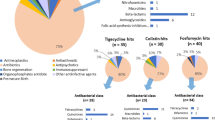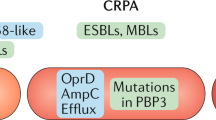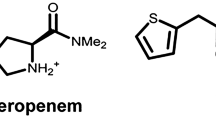Abstract
The global emergence of carbapenem-resistant Enterobacteriaceae (CRE) presents a significant clinical concern, prompting the WHO to prioritize CRE as a top priority pathogen in their 2017 global antibiotic-resistant bacteria priority list. Due to the fast-depleting antibiotic arsenal, clinicians are now resorting to using once-abandoned, highly toxic antibiotics such as the polymyxins and aminoglycosides, creating an urgent need for new antibiotics. Drug repurposing, the application of an approved drug for a new therapeutic indication, is deemed a plausible solution to this problem. A total of 1,163 FDA-approved drugs were screened for activity against a clinical carbapenem- and multidrug-resistant E. coli isolate using a single-point 10 μM assay. Hit compounds were then assessed for their suitability for repurposing. The lead candidate was then tested against a panel of clinical CREs, a bactericidal/static determination assay, a time-kill assay and a checkerboard assay to evaluate its suitability for use in combination with Tigecycline against CRE infections. Three drugs were identified. The lead candidate was determined to be Zidovudine (azidothymidine/AZT), an oral anti-viral drug used for HIV treatment. Zidovudine was shown to be the most promising candidate for use in combination with Tigecycline to treat systemic CRE infections. Further experiments should involve the use of animal infection models.



Similar content being viewed by others
References
Gupta N, Limbago BM, Patel JB, Kallen AJ (2011) Carbapenem-resistant Enterobacteriaceae: epidemiology and prevention. Clin Infect Dis 53:60–67
Satlin MJ, Chen L, Patel G, Gomez-Simmonds A, Weston G et al (2017) Multicenter clinical and molecular epidemiological analysis of bacteremia due to carbapenem-resistant Enterobacteriaceae (CRE) in the CRE epicenter of the United States. Antimicrob Agents Chemother 61:e02349–e02316
Nordmann P (2014) Carbapenemase-producing Enterobacteriaceae: overview of a major public health challenge. Med Mal Infect 44:51–56
Baldwin CM, Lyseng-Williamson KA, Keam SJ (2008) Meropenem: a review of its use in the treatment of serious bacterial infections. Drugs 68:803–838
Morrill HJ, Pogue JM, Kaye KS, LaPlante KL (2015) Treatment options for carbapenem-resistant Enterobacteriaceae infections. Open Forum Infect Dis 2:ofv050
Vergidis PI, Falagas ME (2008) New antibiotic agents for bloodstream infections. Int J Antimicrob Agents 32:S60–S65
El-Gamal MI, Brahim I, Hisham N, Aladdin R, Mohammed H et al (2017) Recent updates of carbapenem antibiotics. Eur J Med Chem 131:185–195
Hsu LY, Apisarnthanarak A, Khan E, Suwantarat N, Ghafur A et al (2017) Carbapenem-resistant Acinetobacter baumannii and Enterobacteriaceae in South and Southeast Asia. Clin Microbiol Rev 30:1–22
Jain A, Hopkins KL, Turton J, Doumith M, Hill R et al (2014) NDM carbapenemases in the United Kingdom: an analysis of the first 250 cases. J Antimicrob Chemother 69:1777–1784
Kazmierczak KM, Rabine S, Hackel M, McLaughlin RE, Biedenbach DJ et al (2015) Multiyear, multinational survey of the incidence and global distribution of metallo-β-lactamase-producing Enterobacteriaceae and Pseudomonas aeruginosa. Antimicrob Agents Chemother 60:1067–1078
Ling ML, Tee YM, Tan SG, Amin IM, How KB et al (2015) Risk factors for acquisition of carbapenem resistant Enterobacteriaceae in an acute tertiary care hospital in Singapore. Antimicrob Resist Infect Control 4:26
Mataseje LF, Abdesselam K, Vachon J, Mitchel R, Bryce E et al (2010) Results from the Canadian Nosocomial Infection Surveillance Program on carbapenemase-producing Enterobacteriaceae, 2010 to 2014. Antimicrob Agents Chemother 60:6787–6794
Pitout JD, Nordmann P, Poirel L (2015) Carbapenemase-producing Klebsiella pneumoniae, a key pathogen set for global nosocomial dominance. Antimicrob Agents Chemother 59:5873–5884
Xu Y, Gu B, Huang M, Liu H, Xu T et al (2015) Epidemiology of carbapenem resistant Enterobacteriaceae (CRE) during 2000-2012 in Asia. J Thorac Dis 7:376–385
Xu A, Zheng B, Xu YC, Huang ZG, Zhong NS et al (2016) National epidemiology of carbapenem-resistant and extensively drug-resistant Gram-negative bacteria isolated from blood samples in China in 2013. Clin Microbiol Infect 22:S1–S8
Nordmann P, Naas T, Poirel L (2011) Global Spread of carbapenemase-producing Enterobacteriaceae. Emerg Infect Dis 17:1791–1798
Logan LK, Weinstein RA (2017) The epidemiology of carbapenem-resistant Enterobacteriaceae: the impact and evolution of a global menace. J Infect Dis 15:S28–S36
Temkin E, Adler A, Lerner A, Carmeli Y (2014) Carbapenem-resistant Enterobacteriaceae: biology, epidemiology, and management. Ann NY Acad Sci 1323:22–42
Frieden T (2013) Antibiotic Resistance Threats in the United States, 2013. Executive Summary. Centers for Disease Control and Prevention, Atlanta, GA, USA. Available online: http://www.cdc.gov/drugresistance/threat-report-2013/ . Accessed 1 July 2017
WHO (2017) Global priority list of antibiotic-resistant bacteria to guide research, discovery, and development of new antibiotics. http://www.who.int/medicines/publications/global-priority-list-antibiotic-resistant-bacteria/en/ . Accessed 1 July 2017
Falagas ME, Kasiakou SK (2005) Colistin: the revival of polymyxins for the management of multidrug-resistant gram-negative bacterial infections. Clin Infect Dis 40:1333–1341
Falagas ME, Lourida P, Poulikakos P, Rafailidis PI, Tansarli GS (2014) Antibiotic treatment of infections due to carbapenem-resistant Enterobacteriaceae: systematic evaluation of the available evidence. Antimicrob Agents Chemother 58:654–663
Karaiskos I, Giamarellou H (2014) Multidrug-resistant and extensively drug-resistant Gram-negative pathogens: current and emerging therapeutic approaches. Expert Opin Pharmacother 15:1351–1370
Zayyad H, Eliakim-Raz N, Leibovici L, Paul M (2017) Revival of old antibiotics: needs, the state of evidence and expectations. Int J Antimicrob Agents 49:536–541
Brust K, Evans A, Plemmons R (2014) Tigecycline in treatment of multidrug-resistant Gram-negative bacillus urinary tract infections: a systematic review. J Antimicrob Chemother 69:2606–1260
Morrill HJ, Pogue JM, Kaye KS, LaPlante KL (2015) Treatment options for carbapenem-resistant Enterobacteriaceae infections. Open Forum Infect Dis 2:1–15
Noskin GA (2005) Tigecycline: a new glycylcycline for treatment of serious infections. Clin Infect Dis 41:S303–S314
Sader HS, Castanheira M, Flamm RK, Mendes RE, Farrell DJ et al (2015) Tigecycline activity tested against carbapenem-resistant Enterobacteriaceae from 18 European nations: results from the SENTRY surveillance program (2010-2013). Diagn Microbiol Infect Dis 83:183–186
Chiu SK, Chan MC, Huang LY, Lin YT, Lin JC et al (2017) Tigecycline resistance among carbapenem-resistant Klebsiella pneumoniae: clinical characteristics and expression levels of efflux pump genes. PLoS One 12:e0175140
Rodríguez-Avial C, Rodríguez-Avial I, Merino P, Picazo JJ (2012) Klebsiella pneumoniae: development of a mixed population of carbapenem and tigecycline resistance during antimicrobial therapy in a kidney transplant patient. Clin Microbiol Infect 18:61–66
FDA (2013) FDA Drug Safety Communication: FDA warns of increased risk of death with IV antibacterial Tygacil (tigecycline) and approves new boxed warning. FDA, Rockville, MD. https://www.fda.gov/drugs/drugsafety/ucm369580.htm. Accessed 1 July 2017
Dixit D, Madduri RP, Sharma R (2014) The role of tigecycline in the treatment of infections in light of the new black box warning. Expert Rev Anti-Infect Ther 12:397–400
Prasad P, Sun J, Danner RL, Natanson C (2012) Excess deaths associated with tigecycline after approval based on noninferiority trials. Clin Infect Dis 54:1699–1709
Falagas ME, Grammatikos AP, Michalopoulos A (2008) Potential of old-generation antibiotics to address current need for new antibiotics. Expert Rev Anti-Infect Ther 6:593–600
Li J, Nation RL, Milne RW, Turnidge JD, Coulthard K (2005) Evaluation of colistin as an agent against multi-resistant Gram-negative bacteria. Int J Antimicrob Agents 25:11–25
Li J, Nation RL, Turnidge JD, Milne RW, Coulthard K et al (2006) Colistin: the re-emerging antibiotic for multidrug-resistant Gram-negative bacterial infections. Lancet Infect Dis 6:589–601
Kaye KS, Gales AC, Dubourg G (2017) Old antibiotics for multidrug-resistant pathogens: from in vitro activity to clinical outcomes. Int J Antimicrob Agents 49:542–548
Pogue JM, Ortwine JK, Kaye KS (2016) Are there any ways around the exposure-limiting nephrotoxicity of the polymyxins? Int J Antimicrob Agents 48:622–626
Tran TB, Velkov T, Nation RL, Forrest A, Tsuji BT et al (2016) Pharmacokinetics/ pharmacodynamics of colistin and polymyxin B: are we there yet? Int J Antimicrob Agents 48:592–597
Yun B, Azad MA, Wang J, Nation RL, Thompson PE et al (2015) Imaging the distribution of polymyxins in the kidney. J Antimicrob Chemother 70:827–829
Aran JM, Erre JP, Lima da Costa D, Debbarh I et al (1999) Acute and chronic effects of aminoglycosides on cochlear hair cells. Ann NY Acad Sci 884:60–68
Huth ME, Ricci AJ, Cheg AG (2011) Mechanisms of aminoglycoside ototoxicity and targets of hair cell protection. Int J Otolarynol 2011:937861
Cosgrove SE, Vigliani GA, Fowler VG Jr, Abrutyn E, Corey GR et al (2009) Initial low-dose gentamicin for Staphylococcus aureus bacteremia and endocarditis is nephrotoxic. Clin Infect Dis 48:713–721
Selimoglu E (2007) Aminoglycoside-induced ototoxicity. Curr Pharm Des 13:119–126
Kaye KS, Pogue JM, Tran TB, Nation RL, Li J (2016) Agents of last resort: polymyxin resistance. Infect Dis Clin N Am 30:391–414
Hu Y, Liu F, Lin IY, Gao GF, Zhu B (2016) Dissemination of the mcr-1 colistin resistance gene. Lancet Infect Dis 16:146–147
Olaitan AO, Morand S, Rolain JM (2016) Emergence of colistin-resistant bacteria in humans without colistin usage: a new worry and cause for vigilance. Int J Antimicrob Agents 47:1–3
Olaitan AO (2016) Emergence of polymyxin resistance in Gram-negative bacteria. Int J Antimicrob Agents 48:581–582
Garneau-Tsodikova S, Labby KJ (2016) Mechanisms of resistance to aminoglycoside antibiotics: overview and perspectives. Med Chem Commun 7:11–27
Poirel L, Jayol A, Nordmann P (2017) Polymyxins: antibacterial activity, susceptibility testing, and resistance mechanisms encoded by plasmids or chromosomes. Clin Microbiol Rev 30:557–596
Rolain JM, Olaitan AO (2016) Plasmid-mediated colistin resistance: the final blow to colistin? Int J Antimicrob Agents 47:4–5
Jayol A, Poirel L, Dortet L, Nordmann P (2016) National survey of colistin resistance among carbapenemase-producing Enterobacteriaceae and outbreak caused by colistin-resistant OXA-48-producing Klebsiella pneumoniae, France, 2014. Euro Surveill 21
Jeannot K, Bolard A, Plésiat P (2017) Resistance to polymyxins in Gram-negative organisms. Int J Antimicrob Agents 49:526–535
Quan J, Li X, Chen Y, Jiang Y, Zhou Z et al (2017) Prevalence of mcr-1 in Escherichia coli and Klebsiella pneumoniae recovered from bloodstream infections in China: a multicentre longitudinal study. Lancet Infect Dis 17:400–410
Wang Y, Tian GB, Zhang R, Shen Y, Tyrrell JM et al (2017) Prevalence, risk factors, outcomes, and molecular epidemiology of mcr-1-positive Enterobacteriaceae in patients and healthy adults from China: an epidemiological and clinical study. Lancet Infect Dis 17:390–399
Zowawi HM, Harris PN, Roberts MJ, Tambyah PA, Schembri MA et al (2015) The emerging threat of multidrug-resistant Gram-negative bacteria in urology. Nat Rev Urol 12:570–584
Kinch MS, Patridge E, Plummer M, Hoyer D (2014) An analysis of FDA-approved drugs for infectious disease: Antibacterial agents. Drug Discov Today 19:1283–1287
Brenner R, Ellis-Grosse EJ, Echols R (2006) Moving goalposts - regulatory oversight of antibacterial drugs. Nat Biotechnol 24:1515–1520
Fernandes P (2006) Antibacterial discovery and development - The failure of success? Nat Biotechnol 24:1497–1503
Nambiar S, Laessig K, Toerner J, Farley J, Cox E (2014) Antibacterial drug development: Challenges, recent developments, and future considerations. Clin Pharmacol Ther 96:147–149
Ashburn TT, Thor KB (2004) Drug repositioning: Identifying and developing new uses for existing drugs. Nat Rev Drug Discov 3:673–683
Nosengo N (2016) New tricks for old drugs. Nature 534:314–316
Oprea TI, Mestres J (2012) Drug repurposing: Far beyond new targets for old drugs. AAPS J 14:759–763
Clinical and Laboratory Standards Institute (2012) Methods for dilution antimicrobial susceptibility tests for bacteria that grow aerobically, approved standard, 9th ed, vol 32, no. 2. Document M07-A9. CLSI, Wayne, PA, USA
French GL (2006) Bactericidal agents in the treatment of MRSA infections - the potential role of daptomycin. J Antimicrob Chemother 58:1107–1117
Hsieh MH, Yu CM, Yu VL, Chow JW (1993) Synergy assessed by checkerboard. A critical analysis. Diagn Microbiol Infect Dis 16:343–349
Sader HS, Farrell DJ, Flamm RK, Jones RN (2014) Variation in potency and spectrum of tigecycline activity against bacterial strains from U.S. medical centers since its approval for clinical use (2006 to 2012). Antimicrob Agents Chemother 58:2274–2280
Small PM, Chambers HF (1990) Vancomycin for Staphylococcus aureus endocarditis in intravenous drug users. Antimicrob Agents Chemother 34:1227–1231
Kaminskas E, Farrell AT, Wang YC, Sridhara R, Pazdur R (2005) FDA drug approval summary: azacitidine (5-azacytidine, Vidaza) for injectable suspension. Oncologist 10:176–182
Jones PA, Taylor SM, Wilson VL (1983) Inhibition of DNA methylation by 5-azacytidine. Recent Results Cancer Res 84:202–211
Uchida T, Kinoshita T, Nagai H, Nakahara Y, Saito H et al (1997) Hypermethylation of the p15INK4B gene in myelodysplastic syndromes. Blood 90:1403–1409
Freireich EJ, Gehan EA, Rall DP, Schmidt LH, Skipper HE (1966) Quantitative comparison of toxicity of anticancer agents in mouse, rat, hamster, dog, monkey, and man. Cancer Chemother Rep 50:219–244
Chabner BA, Drake JC, Johns DG (1973) Deamination of 5-azacytidine by a human leukemia cell cytidine deaminase. Biochem Pharmacol 22:2763–2765
Michalopoulos AS, Falagas ME (2011) Colistin: recent data on pharmacodynamics properties and clinical efficacy in critically ill patients. Ann Intensive Care 1:30–35
Muralidharan G, Micalizzi M, Speth J, Raible D, Troy S (2005) Pharmacokinetics of tigecycline after single and multiple doses in healthy subjects. Antimicrob Agents Chemother 49:220–229
EMA (2017) EMA public assessment report on Vidaza. Document number: Vidaza -EMEA/H/C/000978 -IB/0040. Date: 20/03/2017.www.ema.europa.eu/docs/en_GB/document_library/EPAR_-_Product_Information/human/000978/WC500050239.pdf. Accessed 4 October 2017
Power DG, Kemeny NE (2009) The role of floxuridine in metastatic liver disease. Mol Cancer Ther 8:1015–1025
Wambaugh MA, Shakya VPS, Lewis AJ, Mulvey MA, Brown JCS (2017) High-throughput identification and rational design of synergistic small-molecule pairs for combating and bypassing antibiotic resistance. PLoS Biol 15:e2001644
Chang AE, Schneider PD, Sugarbaker PH, Simpson C, Culnane M et al (1987) A prospective randomized trial of regional versus systemic continuous 5-fluorodeoxyuridine chemotherapy in the treatment of colorectal liver metastases. Ann Surg 206:685–693
Leichman CG (1994) Prolonged infusion of fluorinated pyrimidines in gastrointestinal malignancies: a review of recent clinical trials. Cancer Investig 12:166–175
Mitsuya H, Weinhold K, Furman P, St Clair MH, Lehrman SN et al (1985) 3′-Azido-3′-deoxythymidine (BW A509U): an antiviral agent that inhibits the infectivity and cytopathic effect of human T-lymphotropic virus type III/lymphadenopathy-associated virus in vitro. Proc Natl Acad Sci USA 82:7096–7100
Furman P, Fyfe J, St Clair MH, Weinhold K, Rideout J et al (1986) Phosphorylation of 3′-azido-3′-deoxythymidine and selective interaction of the 5′-triphosphate with human immunodeficiency virus reverse transcriptase. Proc Natl Acad Sci USA 83:8333–8337
Doléans-Jordheim A, Bergeron E, Bereyziat F, Ben-Larbi S, Dumitrescu O et al (2011) Zidovudine (AZT) has a bactericidal effect on enterobacteria and induces genetic modifications in resistant strains. Eur J Clin Microbiol Infect Dis 30:1249–1256
Beach JW (1998) Chemotherapeutic agents for human immunodeficiency virus infection: mechanism of action, pharmacokinetics, metabolism, and adverse reactions. Clin Ther 20:2–25
Elwell LP, Ferone R, Freeman GA, Fyfe JA, Hill JA et al (1987) Antibacterial activity and mechanism of action of 3′-azido-3′-deoxythymidine (BW A509U). Antimicrob Agents Chemother 31:274–280
Lewin CS, Amyes SG (1989) Conditions required for the antibacterial activity of zidovudine. Eur J Clin Microbiol Infect Dis 8:737–741
Blum MR, Liao SH, Good SS, de Miranda P (1988) Pharmacokinetics and bioavailability of zidovudine in humans. Am J Med 85:189–194
Klecker RW Jr, Collins JM, Yarchoan R, Thomas R, Jenkins JF et al (1987) Plasma and cerebrospinal fluid pharmacokinetics of 3′-azido-3′-deoxythymidine: a novel pyrimidine analog with potential application for the treatment of patients with AIDS and related diseases. Clin Pharmacol Ther 41:407–412
Ayers KM (1988) Preclinical toxicology of zidovudine. An overview. Am J Med 85(2A):186–188
Hargreaves M, Fuller G, Costello C, Gazzard B (1988) Zidovudine overdose. Lancet 332:509
Pickus OB (1988) Overdose of zidovudine. N Engl J Med 318:1206
Keith BR, White G, Wilson HR (1989) In vivo efficacy of zidovudine (3′-azido-3′-deoxythymidine) in experimental gram-negative-bacterial infections. Antimicrob Agents Chemother 33:479–483
Spratt BG (1994) Resistance to antibiotics mediated by target alterations. Science 264:388–393
Lewin CS, Watt B, Paton R, Amyes SGB (1990) Isolation of zidovudine resistant Escherichia coli from AIDS patients. FEMS Microbiol Lett 58:141–143
Lewin CS, Allen R, Amyes SGB (1990) Zidovudine-resistance in Salmonella typhimurium and Escherichia coli. J Antimicrob Chemother 25:706–708
Lewin CS, Allen RA, Amyes SGB (1990) Mechanisms of zidovudine resistance in bacteria. J Med Microbiol 33:235–238
Hu Y, Coates A (2014) Combination comprising zidovudine and polymyxin. WO 2014147405 A1
Acknowledgements
The authors thank the Agency for Science, Technology and Research (A*STAR) Biomedical Research Council for funding.
Author information
Authors and Affiliations
Corresponding author
Ethics declarations
Ethical statement
Not required as no humans or animals were involved in this study.
Conflicts of interest
The authors of this paper declare no conflicts of interest.
Rights and permissions
About this article
Cite this article
Ng, S.M.S., Sioson, J.S.P., Yap, J.M. et al. Repurposing Zidovudine in combination with Tigecycline for treating carbapenem-resistant Enterobacteriaceae infections. Eur J Clin Microbiol Infect Dis 37, 141–148 (2018). https://doi.org/10.1007/s10096-017-3114-5
Received:
Accepted:
Published:
Issue Date:
DOI: https://doi.org/10.1007/s10096-017-3114-5




